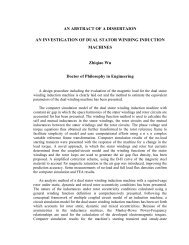CLIFFORD AND GRASSMANN HOPF ALGEBRAS VIA THE ...
CLIFFORD AND GRASSMANN HOPF ALGEBRAS VIA THE ...
CLIFFORD AND GRASSMANN HOPF ALGEBRAS VIA THE ...
Create successful ePaper yourself
Turn your PDF publications into a flip-book with our unique Google optimized e-Paper software.
add(add(BW[i,j]*EV(bas[i],y)*EV(bas[j],x),i=1..2^dim_V),j=1..2^dim_V)<br />
end proc:<br />
> Bsw:=proc(x,i) tcollect(gswitch(contract(&gco(&gco(x,i+1),i),i+1,bw),i))<br />
end proc:<br />
> eq3:=Bsw(Bsw(Bsw(eq0,1),2),1):<br />
> eq4:=Bsw(Bsw(Bsw(eq0,2),1),2):<br />
> is(eq3=eq4);<br />
true<br />
which proves our claim in dim_V=2. As a last demonstration, we check the<br />
remaining properties of a quasi triangular structure to be valid for an exponentially<br />
generated endomap where R S is the convolutive inverse of R.<br />
R(S(a),b)=R S (a, b), R S (a, S(b)) = R(a, b), R(S(a),S(b)) = R(a, b).<br />
Hence we generate the endomap ‘R’ and apply to its arguments the Graßmann<br />
antipode:<br />
> R:=’R’:<br />
> out[1]:=‘R‘=matrix(2^dim_V,2^dim_V,(i,j)-><br />
scalarpart(cmul[R](bas[i],bas[j]))):<br />
> out[2]:=‘RS‘=matrix(2^dim_V,2^dim_V,(i,j)-><br />
scalarpart(cmul[R](gantipode(bas[i]),bas[j]))):<br />
> out[1];out[2];<br />
⎡<br />
⎢ 1 0 0 0<br />
⎢ 0 R1, 1 R1, 2 0<br />
R = ⎢ 0 R2, 1 R2, 2 0<br />
⎣<br />
⎤<br />
⎥<br />
⎦<br />
0 0 0 R2, 1 R1, 2 − R2, 2 R1, 1<br />
⎡<br />
⎢ 1 0 0 0<br />
⎢ 0 −R1, 1 −R1, 2 0<br />
RS = ⎢ 0 −R2, 1 −R2, 2 0<br />
⎣<br />
⎤<br />
⎥<br />
⎦<br />
0 0 0 R2, 1 R1, 2 − R2, 2 R1, 1<br />
> out[3]:=‘RSS‘=matrix(2^dim_V,2^dim_V,(i,j)-><br />
scalarpart(cmul[R](gantipode(bas[i]),gantipode(bas[j])))):<br />
> out[4]:=‘SR‘=matrix(2^dim_V,2^dim_V,(i,j)-><br />
scalarpart(cmul[R](bas[i],gantipode(bas[j])))):<br />
> out[3];out[4];<br />
17
















